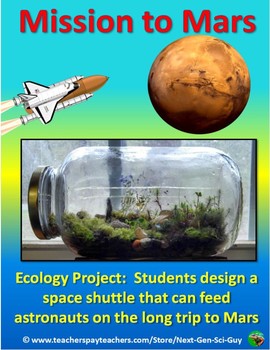Mission to Mars Lab: Design a Ship to Feed Astronauts |NGSS| Distance Learning
- Zip
Description
This ecology project is packed full of NGSS standards, and engages students in STEM activities. It proceeds as follows:
1. First, students consider the hurdles involved in a manned-trip to Mars
2. Then, students use concepts in ecology to design and create a self-sustaining food room for astronauts
3. Finally, students evaluate the strengths and weaknesses of their mini-ecosystem
Time Frame: The initial set up of the project requires one or two classes. Students can then make observations for a few minutes for weeks or even months after the container is sealed.
Details Below:
I'm new to TPT, and would love feedback if you have a minute. I'm adding new content on a weekly basis, so click follow me under my store name to be the first to know.
This product is part of a Unit Bundle, which offers all you need to teach a Unit on Ecology for students grades 7-12.
Get it here: Ecology Unit Bundle
"Animal Cracker Ecology is a great activity to start with before using MIssion to Mars. It is NGSS Aligned.
Get it here: Animal Cracker Ecology
Do you want to grade your class's ECOLOGY test with the click of a button? I created a 50 question Ecology test that grades itself.
Get it here: Self-Grading Ecology Test
A. NEXT GENERATION SCIENCE STANDARDS HEREIN
DCI’s: LS2 Ecosystems: Interactions, Energy, and Dynamics
Cross Cutting Concepts: Scale, Proportion, and Quantity, Systems and System Models, Energy and Matter: Flows, Cycles, and Conservation
Scientific and Engineering Practices:
Asking Questions and Defining Problems, Planning and Carrying Out Investigations, Designing solutions, Developing and Using Models, Evaluating, and Communicating Information
B. SUGGESTED USES
Prior Knowledge: Students should have an understanding of energy flow through ecosystems (energy pyramid, food chains, and the basic niches (producers, consumers, decomposers).
Materials and Setup: Students will need a container (terrarium, water jug, giant pretzel barrel), ecosystem materials (plants, animals, soil, rocks, water), and tape to seal it eventually. I emphasize that the container must be a closed system (once sealed), and should not be open to the air around it.
The container isn't hard to obtain. The abiotic and biotic factors can be collected by taking a class outside (if possible), or could be purchased.
The project can last as long as you want (I've run it for almost the whole year before, or as short as two to three weeks).
One of the benefits of this activity is that it's useful for many different grades.
Implementing the Lesson:
1. Ask students to list the differences between a trip to the Moon vs. a trip to Mars, by listing their answers on the first question of the assignment. (you might have to prompt them by giving them categories to focus on: the time it will take, the amount of supplies they require, the amount of time they will spend away from Earth, effects of microgravity, getting rid of waste, etc.)
2. Discuss their answers to number one as a class. This could also touch upon the concept that organisms, including humans, have evolved to become adapted to the environment in which we live. Space is a very different environment, and we are poorly adapted to survive in space.
3. Watch the video comparing the two trips. https://www.wired.com/2016/02/year-space-scott-kelly/
4. Now, have them write a list of possible solutions to the following question; "If you were a scientist who worked on the NASA team that planning the Mission to Mars, how would you make sure that the astronauts had enough food on the long trip, (for more than a year, most likely)?" IN THE SPACE PROVIDED.
5. Discuss their answers as a class.
6. Introduce the goal of the project, which is to design and test a prototype of a self-sustaining food room for astronauts. Students can work through the packet in order from there.
7. After students have made observations for at least two weeks, they can answer the ASSESSMENT and CONCLUSION questions.
8. I usually give students an exit ticket (whenever you deem fit: after the first day, or at the very end of the project).
EXIT TICKET: Sometime scientists compare our planet to a spaceship; a spaceship that they call "Spaceship Earth". How is Earth like a spaceship? (answers at end of packet)
My students enjoy this activity. If yours liked it, there are more like this at my TpT store:
http://www.teacherspayteachers.com/Store/Next-Gen-Sci-Guy
Terms of Use
• This packet is 1 classroom/teacher use only. Do not make copies or
email it to your colleagues. This was designed by me and is for your
personal (one user)use. You may
not share it or claim it as your own. You may not redistribute it.
If colleagues are interested in it, please send them the link to my store:
https://www.teacherspayteachers.com/Store/Next-Gen-Sci-Guy
• You are not permitted to use any part of this work to
create products for sharing or selling.
• You are permitted to share the cover image of the packet
on your website when referring to it in a post, as long as
you link back to my store.
All rights reserved by author.





